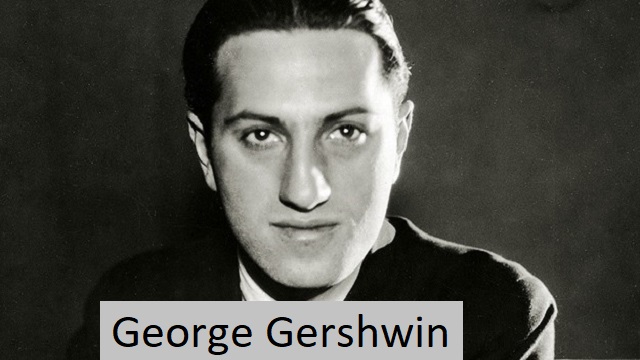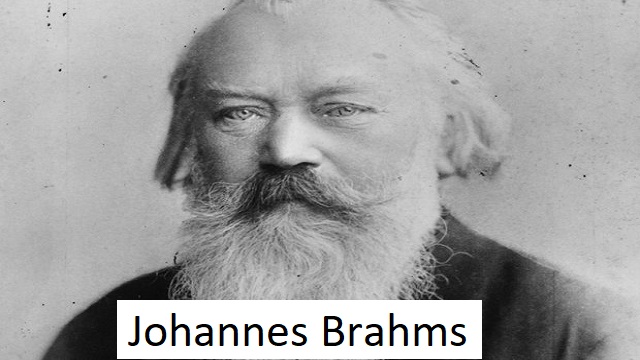George Gershwin, formerly Jacob Gershwin (born September 26, 1898, Brooklyn, New York, USA – died July 11, 1937, Hollywood, California) is one of the most important and popular American composers in history. Just me. Although he wrote primarily for the Broadway musical theater, his orchestral and piano compositions, in which he blends classical musical forms and techniques with varying degrees of jazz and folk music nuances and techniques, are also important.

Early career and influence
Gershwin was the son of Russian Jewish immigrants. Although his family and friends discouraged music, Gershwin developed an early interest in music through exposure to popular and classical songs he heard at school and in the penny arcade. His musical education began at the age of 11 when his family bought a used upright piano. This was ostensibly so that George’s older brother Ira could learn to play an instrument. When George amazes everyone with his fluent playing of folk songs, which he taught himself by tracing the keys of his neighbor’s piano, his parents decide that George is the lesson family. become a member of He studied piano with the eminent teacher Charles Hampetzer and introduced his young students to the works of the great classical composers. Hampetzer was so impressed with Gershwin’s potential that he refused to pay his tuition. He wrote in a letter to his sister: This boy is a genius.
Gershwin continued to expand his musical knowledge and compositional skills throughout his career with various mentors such as the distinguished American composers Henry Cowell and Wallingford Rieger, the renowned traditionalist Edward Kilney, and the music theorist Joseph Schillinger, known for his mathematical approach to composition. is, he continued. After dropping out of school at age 15, Gershwin earned a living producing piano rolls for pianists and performing in New York nightclubs. His main work during this period was his stint as a song plugger (perhaps the youngest of Tin Pan Alley), performing sheet music for the Jerome Remick Music Publishing Company. At a time when sheet music sales determined a song’s popularity, song pluggers like Gershwin worked long hours to play tunes on the piano for potential customers. Gorswin’s rapidly growing creativity said, “Gorswin Electrical Artist Isaac Goldberg has been interrupted by a three -year smell, but still, he has improved his skill and improvement and implementation competencies. Gorsuen was considered one of the most gifted pianists in New York while still in his teens, working as a trial pianist for famous singers and sangat for broadway music. In 1916, he released his first published song, “When You Want ‘Em You Can’t Get ‘Em (When You’ve Got ‘Em You Don’t Want’Em)” and his first song, “When You’ve I got them, you don’t want them.” solo piano composition “Rialto Waves .” He began to attract the attention of some Broadway celebrities, and operetta composer Sigmund Romberg included one Gershwin’s song from The Passing Show, 1916.
These early experiences greatly expanded Gershwin’s knowledge of jazz and popular music. He particularly enjoyed the music of Irving Berlin and Jerome Kern, who referred to Berlin as “the American Franz Schubert” and noted that Kern was “the first composer to make me realize that the most popular music is of inferior quality and that musical comedies be made of better” – and her work inspired him to compose for the Broadway stage. In 1919, Al Jolson performed Gershwin’s Swanee in the musical Sinbad. It was a huge hit, selling more than two million records and a million sheet music copies, and made Gershwin an overnight celebrity. In the same year, La La Lucile, the first play composed entirely by Gershwin. Some of his most popular songs include “The Best of Everything”, “Nobody But You” and “T-Odle-M-Boom-Boo”. Also in 1919, Gershwin composed his first “serious” work, a lullaby for string quartet. A coordinated study by Gershwin as an exercise in Killeny, the tender beauty of the lullaby transcends its academic roots. Published by Ira Gershwin a few years after George’s death, it became popular for string quartets and symphonies and was later recorded.
Fascination with the color blue
Over the next several years, Gershwin performed songs in Broadway shows and plays. From 1920 to 1924 he composed the score for the annual production of the popular entertainment show George White’s Scandal, including “(I) Will Build the Stairway to Paradise” and “Somebody Loves Me”. ” and other standard songs. In 1922’s Scandal, Gershwin persuaded producer White to incorporate a one-act jazz opera. The production, titled Blue Monday (later reworked and renamed 135th Street), was poorly received and was removed from the show after one performance. Conductor Paul Wightman, who had conducted the Pit Orchestra for the show, was nonetheless impressed by the piece. He and Gershwin shared a goal of bringing respect to jazz, which in 1922 was still, as the New York American editors testified, “degrading, morbid, unnerving, sex-exciting music.” To Later in 1923, Whiteman asked Gershwin to compose a piece of music called “An Experiment in Modern Music” at the Aeolian Concert Hall in New York. Legend has it that Gershwin forgot about the request until early January 1924 when he read a newspaper article announcing that a major new composition by Gershwin would be performed at Whitman’s concert on February 12. . Writing at a breakneck pace to meet deadlines, Gershwin composed perhaps his most famous work, Rhapsody in Blue, in three weeks. Hastily written, “Rhapsody in Blue” had a somewhat shaky premiere. Gershwin improvised much of the piano solo during the performance, and conductor Whiteman had to rely on Gershwin’s gestures to lead the orchestra at the end of the solo. Nevertheless, the play was a huge success and Gershwin became world famous. The groundbreaking work incorporated the idiom’s hallmarks (blue notes, grouped rhythms, and spoken instrumental effects) into a symphonic context. Gershwin himself later reflected on this work as follows:
Much has been said about the limits of jazz, not to mention the apparent misunderstandings about its function. Jazz must be going through a tough time, they said. You had to stick to the dance rhythms. I decided, if possible, to squash this misunderstanding with a bang… There was no definite plan in my mind, no framework to match my music. Rhapsody started with a goal, not a plan.
Arranged by Ferde Grofé (composer of the Grand Canyon Suite) for symphony orchestra or jazz band, it is perhaps the most performed and best-recorded orchestral work of the 20th century. It is the only one of Gershwin’s major works not arranged by Gershwin himself.
Popular Songs of George Gershwin
For the remainder of his career, Gershwin devoted himself to both popular song and orchestral composition. Broadway showed in the twenties and thirties of the last century showed a number of songs that have become standard. I, ‘Ride the Band’, ‘I Love You’, ‘Awesome’, ‘Drifting for You’, ‘My Time’, ‘My Time’, ‘You You’, ‘Can’t’, ‘I Say’; or “I read in you ”and This is not sympathy. He has also composed many songs for Hollywood movies. Good product. “Love Come” and “I love staying here.” The lyrics of his song, almost all songs, his brother Ira, humor, humor -immersed the lyrics of his song with almost popular language, punishment and words. As much as George’s admiration.
GARSHWIN BROTHERS consists of a unique composition of George’s tune in the first stage. Unlike the work of most of the composer’s team. (When the interviewer asked, which came first, the song or the music?(Ira’s usual response was “deal”). George’s musical imagination was so simple that most of his good songs were composed in a few minutes of improvisation. Sometimes I rummage through sketches of songs I’ve collected over time (he once said, “There’s more tunes in my head than I could put down on paper in a100 years”) and the accompanying old song “g.t. (means “good air”). Ira then spent over a week tailoring the melody until she was satisfied, refining each line (to the point that other composers nicknamed her “The Jeweler”). Composer Arthur Schwartz viewed Ira’s efforts as “quite a remarkable achievement, as she must excel at tighter rhythms and accents.”
One of the Gershwins’ most famous collaborations, “I Got Rhythm”, was performed by Ethel Merman in the musical Girl Crazy (1930). The following year Gershwin recorded a long and elaborate arrangement for piano, and in late 1933 he arranged the piece as a medley for piano and orchestra. The variations on “I Got Rhythm” have since become one of Gershwin’s most frequently performed orchestral works. Additionally, the 32-bar structure of “I Got Rhythm” has become the second most used harmonic progression in jazz improvisation, after the traditional 12-bar blues.
Gershwin’s piano score for “I Got Rhythm” was part of a larger project that began with George Gershwin’s Songbook in 1931. Among his visits, Gorusvin’s favorite collection is that he describes an adaptation of musicians designed for advanced pianists.
Other orchestra features
In 1925, Gorgeslvin was asked to write a concert at the New York Symphony Association and was inspired by musicians to comment. London. After buying four or five books on the structure of the music, what is actually to find the shape of this concert! F (1925), a conclusion concert, was the longest configuration of Gurchin and is divided into three traditional concerts. The first movement loosely follows an exposition-development-summary sonata structure, borrowing themes and rhythms from the popular “Charleston”. According to Walter Damrosch, the conductor who conducted the first performance, the second movement is “the culmination of [Gershwin’s] genius”, a quiet and meditative adaptation of the blues progression, On the other hand, Gershwin called the third movement “a festival of rhythm”. Although not as well received as Rhapsody in Blue at the time, the concerto in F major eventually came to be considered one of Gershwin’s most important works, and perhaps the most popular American piano concerto. Gershwin’s second best orchestral work, An American in Paris (1928), is inspired by the composer’s trip to Paris in the 1920s. His stated intention with this piece was to “depict the impressions of an American visiting Paris as he strolled through the city, listening to the various noises of the streets and absorbing the atmosphere of France”. To that end, Gershwin incorporated realistic touches such as the horns of authentic French cars. This piece is perhaps best represented by Gershwin’s use of jazz and classical forms. The harmonic structure of “An American in Paris” is rooted in the blues tradition (especially the middle part of “Homeland Blues”), and the soloists often have to bend, slide, and murmur certain notes and parts, in the style of jazz. Musicians of the Twenties. But the melody, repeated and embellished throughout the piece, never changes. This contrasts with jazz philosophies that view melodies as drafts for imaginative embellishments. With its varied rhythms and unconventional structure (“five sections joined together by more or less intuition”, as one critic put it), An American in Paris is more of a ballet than a symphony, and indeed it has earned him his most enduring reputation. 23 years later. It premiered in 1951 when Gene Kelly used it in the closing ballet scene for the classic musical film of the same name. Gershwin’s other orchestral compositions have grown in prestige and popularity over the years. His Second Rhapsody (1931) was given the working titles Manhattan Rhapsody and Rhapsody on the Rivet and was featured in embryonic form as incidental music in the film Yummy (1931). This is perhaps the most experimental of Gershwin’s major works and has been hailed as his best composition in terms of both structure and orchestration.






